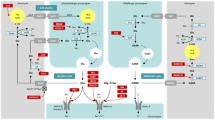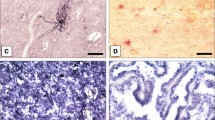Abstract
N-acetyl-L-aspartate (NAA), an abundant amino acid present in the vertebrate brain, is synthesized and stored primarily in neurons. Its metabolism is also dynamic, with NAA turning over more than once each day by its regulated efflux into extracellular fluid (ECF), cycling between an anabolic L-aspartate acetylating compartment in neurons and a catabolic NAA deacetylating compartment in oligodendrocytes. An inborn error in NAA metabolism results in Canavan disease (CD), a rare and usually fatal early-onset autosomal recessive human central nervous system (CNS) disease, caused by failure of the catabolic metabolism of NAA resulting from a lack of sufficient amidohydrolase II activity in oligodendrocytes. Various hypotheses regarding the metabolism of NAA and its role have been considered, and although NAA may perform several functions in the CNS, an important role of NAA appears to be osmoregulatory. Based on this role, an osmotic-hydrostatic mechanism for the etiology of the CD phenotype is proposed. In CD, the daily addition of 13375 Pascals (0.132 atmospheres or 1.94 lbs per square inch) of hydrostatic pressure to brain ECF, on the brain cell side of brain-barrier epithelial membranes, resulting from the continuous synthesis and efflux of NAA, is considered to be responsible for the syndrome.
Similar content being viewed by others
References
Baslow M. H. (1999) Molecular water pumps and the aetiology of Canavan disease: A case of the sorcerer’s apprentice. J. Inher. Metab. Dis. 22, 99–101.
Baslow M. H. (2000) Canavan’s spongiform leukodystrophy: a clinical anatomy of a genetic metabolic CNS disease. An analytical review. J. Mol. Neurosci. 15, 61–69.
Baslow M. H., Suckow R. F., Berg M. J., Marks N., Saito M., and Bhakoo K. K. (2001) Differential expression of carnosine, homocarnosine and N-acetyl-L-histidine hydrolytic activities in cultured rat macroglial cells. J. Mol. Neurosci. 17, 87–95.
Baslow M. H. (2002) Evidence supporting a role for N-acetyl-L-aspartate as a molecular water pump in myelinated neurons in the central nervous system. An analytical review. Neurochem. Int. 40, 295–300.
Baslow M. H. and Guilfoyle D. N. (2002) Effect of N-acetylaspartic acid on the diffusion coefficient of water: a proton magnetic resonance phantom method for measurement of osmolyte-obligated water. Analyt. Biochem. 311, 133–138.
Baslow M. H. (2003) N-acetylaspartate in the vertebrate brain: metabolism and function. Neurochemical Res. 28, 941–953.
Bates T. E., Strangward M., Keelan J., Davey G. P., Munro P. M., and Clark J. B. (1996) Inhibition of N-acetylaspartate production: implications for 1 H MRS studies in vivo. Neuroreport. 7, 1397–1400.
Bray D., Money N. P., Harold F. M., and Bamburg J. R. (1991) Responses of growth cones to changes in osmolality of the surrounding medium. J. Cell. Sci. 98, 507–515.
Martin E., Capone A., Schneider J., Hennig J., and Thiel T. (2001) Absence of N-acetylaspartate in the human brain: impact on neurospectroscopy? Ann. Neurol. 49, 518–521.
Meinild A.-K., Klaerke D. A., Loo D. D. F., Wright E. M., and Zeuthen T. (1998) The human Na+-glucose cotransporter is a molecular water pump. J. Physiol. 508, 15–21.
Moreno A., Ross B. D., and Bluml S. (2001) Direct determination of the N-acetyl-L-aspartate synthesis rate in the human brain by 13C MRS and [1-13C]glucose infusion. J. Neurochem. 77, 347–350.
Sager T. N., Thomsen C., Valsborg, J. S., Laursen H., and Hansen, A. J. (1999) Astroglia contain a specific transport mechanism for N-acetyl-L-aspartate. J. Neurochem. 73, 807–811.
Author information
Authors and Affiliations
Corresponding author
Rights and permissions
About this article
Cite this article
Baslow, M.H. Brain N-acetylaspartate as a molecular water pump and its role in the etiology of canavan disease. J Mol Neurosci 21, 185–189 (2003). https://doi.org/10.1385/JMN:21:3:185
Received:
Accepted:
Issue Date:
DOI: https://doi.org/10.1385/JMN:21:3:185




